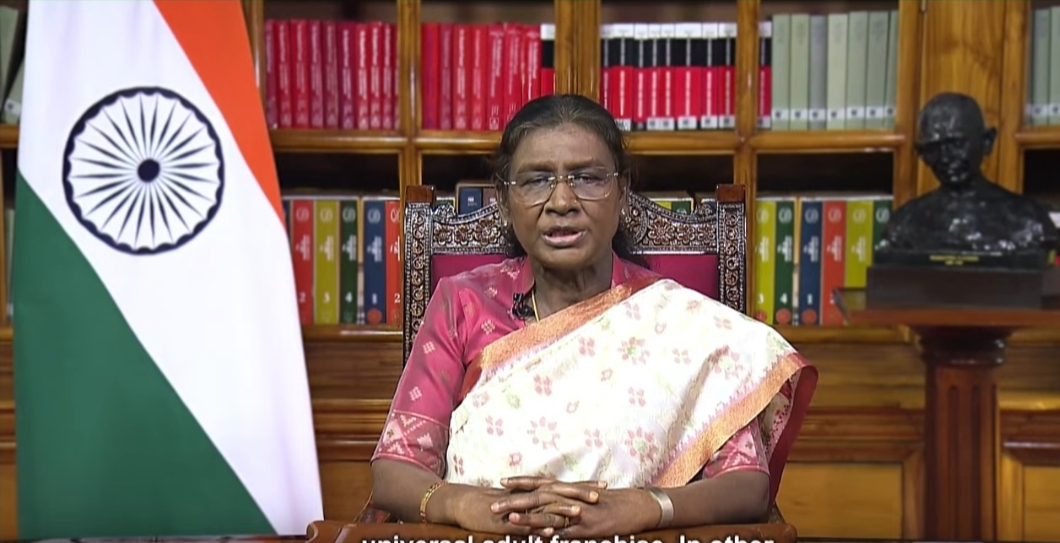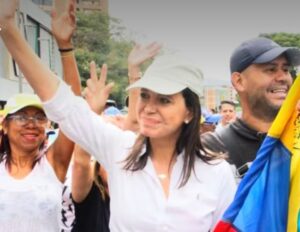On the eve of the 79th Independence Day, President Droupadi Murmu reminded the nation that justice, liberty, equality, and fraternity, rooted in our civilisational ethos,form the pillars of our democracy, with human dignity at their core. She stressed that every citizen must have equal access to healthcare, education, and opportunities, and that those historically disadvantaged deserve a helping hand. This reaffirmation of constitutional values comes at a politically sensitive time, prompting a simple question a common citizen might ask the custodian of our Constitution: Madam President, did you feel the need to remind the Modi Government and its supporters of these fundamental principles of the constitution and our rich civilization because they are being overlooked in today’s governance!
Here’s the things: when formal trappings of independence, such as parades, speeches and slogans, start to feel hollow, celebration becomes an act of reckoning. What we’re seeing now is not just popular anger. It’s a mass response to systemic economic squeeze, manipulative governance and the hollowing out of democratic symbols. If Independence is to be reclaimed by citizens rather than stage-managed by the state, that reclamation must be strategic, lawful and sustained. Below is a framework for how that might look in practice, practical, constitutional and oriented toward mass, non-violent civic pressure.
What this really means is shifting the focus from spectacle to substance. Instead of allowing national ritual to be confined to government-orchestrated events, citizens should create spaces for public deliberation: community assemblies, expert panels and online forums where policy, budgets and national priorities are discussed in plain language.
Organise “People’s Independence Day” events in community halls, parks and virtual platforms. Make them hubs for evidence-based debate, sessions where economists, public-interest lawyers and independent journalists present data and alternatives. The point is not to replace national ceremonies, but to reclaim the meaning of independence as civic agency rather than choreographed patriotism.
Manipulative messaging succeeds when facts are hard to access and easy to obscure. A public literacy campaign can cut through that fog. Use short, shareable explainers, fact-checked infographics, brief videos and town-hall discussions to show how selective statistics, pseudo-indicators and skewed media coverage distort reality.
Partner with independent economists, journalists and legal experts to counter false narratives. Keep material concise and verifiable. Prioritise transparency, cite primary sources, explain methodologies where possible, and present counter-analyses that ordinary readers can follow.
Large-scale economic strikes or illegal refusals to pay taxes are neither safe nor advisable. That said, symbolic and lawful acts can communicate dissent without exposing participants to criminal charges. Examples of calibrated, low-risk initiatives include coordinated one-day cash-only transactions to draw attention to digital-payment policies, or designated no-spend days to highlight the human cost of austerity and inflation.
What matters is framing. These actions should be explicitly symbolic and couched as peaceful economic expression, not as calls to evade legal obligations. Citizens and organisers must be clear that the objective is visibility and awareness, not financial sabotage, and should seek legal guidance where the line between protest and illegality might be uncertain.
Transparency campaigns are the backbone of civic oversight. Use Right to Information requests to probe opaque spending, subsidies that benefit private entities, and the economics of major infrastructure projects. Collate findings into “People’s Audit” reports and publish them widely through citizen media channels and social networks.
Make these audits accessible: executive summaries, visualisations of public funds, and plain-English explanations of complex contracts. The aim is to turn secrecy into scrutiny and to empower ordinary citizens to demand answers from public officials and corporations alike.
There’s a constitutional framework available for public action: freedom of speech, the right to assemble, and the right to life with dignity (Articles 19 and 21). Use these guarantees as the basis for mobilisation. Peaceful marches, signature campaigns and petitions that explicitly reference constitutional provisions are harder to dismiss as mere disruptions.
Scale matters. Non-violent numbers that cannot be ignored by mainstream institutions and media create political pressure. But scale must be organised: clear codes of conduct, designated marshals, legal observers and medical volunteers help ensure demonstrations remain peaceful and safe for participants.
Longevity requires structure. Form citizens’ committees across districts to coordinate actions, verify information and consolidate demands. These local committees should be grassroots-led, accountable to their communities, and networked nationally through secure, open channels.
Technology can help synchronise activity, but the movement must stay bottom-up. Committees should prioritise transparency in decision-making and rotate responsibilities to prevent capture by any single group or leader.
Governments often weather short, intense bursts of protest. The strategy must therefore be cyclical and escalating within legal bounds: begin with symbolic acts that raise awareness, escalate to coordinated civic-economic expressions that are lawful and clearly framed, and culminate in electoral organizing that holds officials to account at the ballot box.
This kind of escalation demands patience, organisation and a clear set of demands that are communicated repeatedly and simply. Aim for campaigns that can be renewed periodically, maintaining momentum without burning out volunteers.
Domestic pressure is essential, but international scrutiny can amplify citizen concerns in ways internal protest sometimes cannot. Engaging reputable international watchdogs, human-rights organisations and global media can lend visibility and create diplomatic or reputational costs for rights erosion or economic mismanagement.
That said, international engagement should be pursued carefully and transparently. Work through recognised, credible institutions and focus on documented facts rather than emotive claims. International solidarity should support, not substitute for, domestic action.
Direct calls to break tax laws or disrupt banking systems risk criminalisation and can delegitimise a movement. Any economic action must be framed as symbolic civil disobedience within constitutional boundaries. Legal counsel and rights bodies should review proposed tactics in advance. Non-violence, clarity of purpose and respect for the rule of law are not merely ethical choices, they are strategic necessities that protect participants and preserve legitimacy.
What this framework insists on is simple: reclaiming Independence requires more than anger. It requires strategy rooted in constitutional rights, supported by facts, sustained through organised networks and protected by the rule of law. Celebrate by speaking truth to power, but do so in ways that are visible, verifiable and lawful. That is how a symbolic day can become the start of a durable democratic renewal.
If the goal is a real Independence celebration, one where citizens reclaim agency rather than merely change the backdrop for the same politics, the approach must be deliberate, legally safe and collective. The country’s future depends on civic actions that are as disciplined as they are determined.
Here’s the thing: when formal trappings of independence, such as parades, speeches and slogans, start to feel hollow, celebration becomes an act of reckoning. What we’re seeing now is not just popular anger. It’s a mass response to systemic economic squeeze, manipulative governance and the hollowing out of democratic symbols. If Independence is to be reclaimed by citizens rather than stage-managed by the state, that reclamation must be strategic, lawful and sustained. Below is a framework for how that might look in practice, practical, constitutional and oriented toward mass, non-violent civic pressure.
What this really means is shifting the focus from spectacle to substance. Instead of allowing national ritual to be confined to government-orchestrated events, citizens should create spaces for public deliberation: community assemblies, expert panels and online forums where policy, budgets and national priorities are discussed in plain language.
Organise “People’s Independence Day” events in community halls, parks and virtual platforms. Make them hubs for evidence-based debate, sessions where economists, public-interest lawyers and independent journalists present data and alternatives. The point is not to replace national ceremonies, but to reclaim the meaning of independence as civic agency rather than choreographed patriotis
Manipulative messaging succeeds when facts are hard to access and easy to obscure. A public literacy campaign can cut through that fog. Use short, shareable explainers, fact-checked infographics, brief videos and town-hall discussions to show how selective statistics, pseudo-indicators and skewed media coverage distort reality.
Partner with independent economists, journalists and legal experts to counter false narratives. Keep material concise and verifiable. Prioritise transparency, cite primary sources, explain methodologies where possible, and present counter-analyses that ordinary readers can follow.
Symbolic economic non-cooperation, low risk and high visibility
Large-scale economic strikes or illegal refusals to pay taxes are neither safe nor advisable. That said, symbolic and lawful acts can communicate dissent without exposing participants to criminal charges. Examples of calibrated, low-risk initiatives include coordinated one-day cash-only transactions to draw attention to digital-payment policies, or designated no-spend days to highlight the human cost of austerity and inflation.
What matters is framing. These actions should be explicitly symbolic and couched as peaceful economic expression, not as calls to evade legal obligations. Citizens and organisers must be clear that the objective is visibility and awareness, not financial sabotage, and should seek legal guidance where the line between protest and illegality might be uncertain.
Transparency campaigns are the backbone of civic oversight. Use Right to Information requests to probe opaque spending, subsidies that benefit private entities, and the economics of major infrastructure projects. Collate findings into “People’s Audit” reports and publish them widely through citizen media channels and social networks.
[Writer is a Senior Journalist and Political Commentator]






